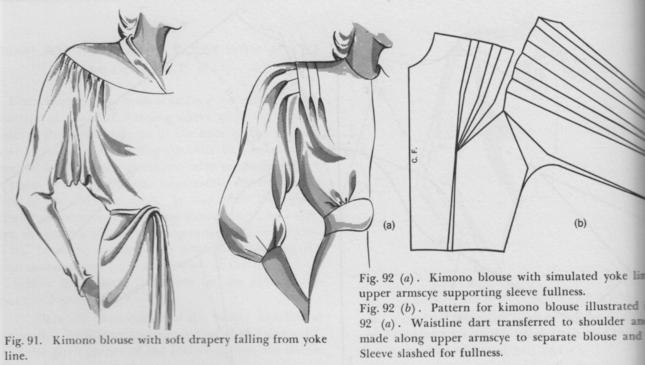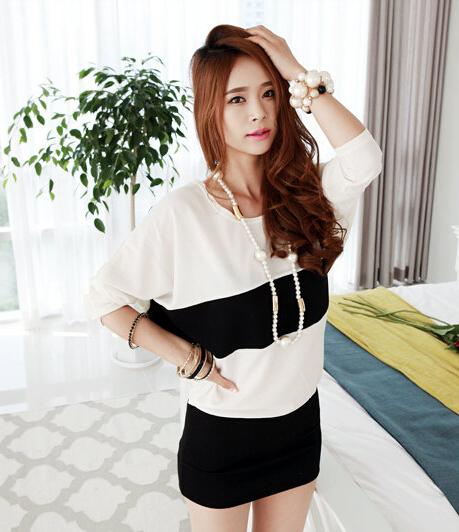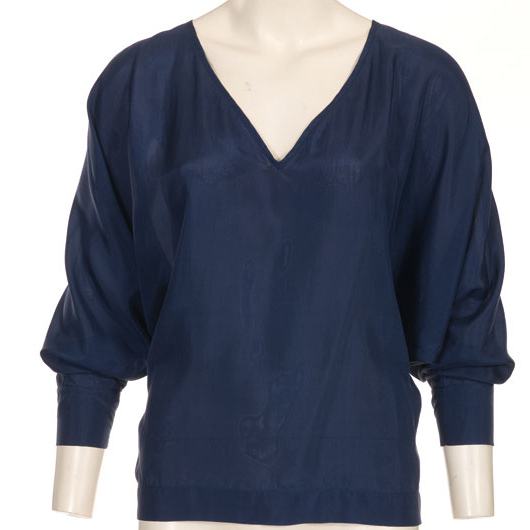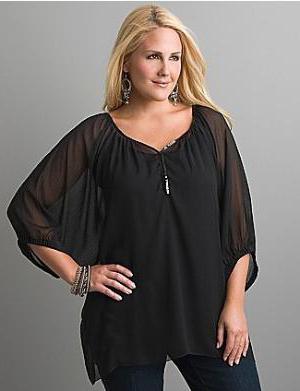If you go shopping with branded clothing, you can see that almost half of the things are tailored to the simplest patterns. T-shot silhouette is extremely popular today. What is t-shot? This is a blouse with one-piece sleeves, the pattern of which in shape resembles the Russian letter "T". It’s not at all difficult to tailor and stitch a model according to such a pattern.
Fabric selection
So that a thing can be worn for several seasons, you should especially carefully choose the material from which you are going to sew. First of all, you should abandon the colors that do not fit your appearance and type. It is equally important to determine for what occasion the blouse is intended, with which of the things in the wardrobe it can be combined, how practical the fabric is in care. Also pay attention to whether it is too complicated to sew. If you do not have much experience in cutting and sewing, then do not buy moody fabrics such as velvet, or chiffon, with sequins or bead embroidery, loose and with complex prints.
Taking measurements
Building a pattern of blouses with a one-piece sleeve begins with taking measurements and determining the size of the product. The main measures for this case:
- chest circumference. It is measured at the most prominent points of the chest and shoulder blades. For construction, half of this value is used;
- length of the product. It is measured along the back from the seventh cervical vertebra to the alleged bottom of the product;
- the length of the sleeve. From the junction of the forearm to the shoulder.
Look at the photo of the pattern. It looks like any, even the most avant-garde and trendy blouse with one-piece sleeves. The pattern should work for everyone. It can be built in a reduced form on a sheet of a school notebook. After clarification, modeling and verification, transfer the drawing in full size to a large sheet of tracing paper or graph paper. This pattern is also used for cutting fabric. The most daring dressmakers draw a model directly on matter. Usually this applies to cases when the figure is slim, the style does not require a snug fit, and the material without a complex pattern.
When building, allowances for freedom of movement should be taken into account. For thin, flowing fabrics, it should be large enough - from 10 cm or more. For dense or poorly drapable materials, respectively, no more than 10 cm. Standard shoulder bevel - 2-2.5 cm.
Seam allowances are:
- along the neck - 1 cm;
- on the bottom - 4 cm;
- at the seams - 1.5 cm.
Perfect shoulder fit is the key to model success
With individual tailoring, even a simple blouse of a free silhouette can be ideally planted on the figure. The shoulder slope is individual for everyone, and consumer products use average figures. This also applies to the circumference of the neck. The ideal depth and shape of the cutout for each person is different.
Since a simple pattern of a blouse with a one-piece short sleeve can serve for a long time and become the basis for many things, it is better to make a good and accurate pattern with an ideal shoulder line and neckline. Take as a basis any shoulder product without shoulder pads. If there is a mannequin with your indicators - work on it. If not, call for help from a person who has some understanding in the cut. Trying and fitting clothes on yourself is impossible to do. To make the right shoulder line, you should wear a dress, shirt or blouse - a thing that can be used to create the perfect pattern. Chip with pins along the lines of the sides, the middle of the back and the front, so that it fits tightly on the torso. After that, pin the shoulder line with pins, not across, but along, that is, as you will be laying the seam. Mark with chalk the point of the base of the neck and the point of connection of the shoulder and arm. Focusing on the reflection in the mirror, draw a neckline. Trim the excess around the circumference of the neck and along the shoulder line. Leave a shoulder seam allowance of 1-1.5 cm.

An oversize should not be made on the neckline of the layout. This is the best way to see the most advantageous cutout shape.
Sideline and short sleeve
Now you can loosen the side seams. Determine how loose the blouse should be in the chest, waist, and hips. Pin the side seams again with pins. Chalk the lines of the side seams. Cut off excess tissue. Carefully remove the breadboard from the mannequin. Extend the side seam lines up to the intersection with the shoulder lines.
This completes the construction of a pattern blouse with a short one-piece sleeve. The layout can be used as a finished pattern, or you can redraw it on paper. On the basis of such mock-ups, not only blouses are modeled, complicating them with cut-out details, undercuts, fasteners and yokes, but also dresses, and even coats.
Extend the sleeve
To get a pattern of a blouse with a one-piece long sleeve, increase the size of the allowance for a loose fit, mark the beginning point of the armhole on the side seam. The depth of the armhole in the case of a one-piece sleeve should be several centimeters lower than for the set-in sleeve. Extending the shoulder line, get the line of the upper seam of the sleeve. From the lower point of the armhole draw a line parallel to the line of the upper seam of the sleeve. Sleeve cut - a line connecting the upper and lower seams of the sleeve and forming right angles with these lines. If desired, the sleeves can be made narrower or wider, decorated with cuffs or drawstring with frills.
It is very easy to work with our universal pattern if it is made of thick paper and made in duplicate. This is convenient for modeling and when working with matter having complex packing.
Big size
Ladies of corpulent sizes, with a physique that requires adjustment, it is worth paying attention to models complicated by sub-core parts, in particular, coquettes. The main pattern of a blouse with a one-piece sleeve of a large size is built, focusing, in addition to the above values, also on the circumference of the abdomen, hips and forearm. The width of the blouse is determined based on the widest part of the figure. A loose summer blouse made of thin cotton gauze or an office blouse made of silk satin will decorate and present in the best possible way and full ladies. It is only necessary to think over and choose the right decoration elements.
Modeling a round yoke blouse
A blouse pattern with a round yoke and a one-piece sleeve is modeled as follows. Looking at the reflection in the mirror, determine the location line of the round yoke. Chalk marks of the landmark. Transfer them to a paper pattern. Cut off from the paper patterns of the base along the drawn line.

The yoke is used for cutting unchanged. Only around its perimeter is 1.5 cm added - an allowance for seams. This part is cut out of the main fabric twice, since the coquette should be more rigid than the whole blouse, and it is better to keep the shape. After the coquette has been cut off from the main pattern, on the whole pattern of the front, back and sleeves the lines are extended, increasing the width of these parts by as much as you want and as much as the fabric stock allows. Before connecting to the yoke, these excesses are folded into or creased by sewing machine stitches. Having leveled the length of the cut of the top of the lower part of the blouse with the length of the lower edge of the coquette, they should be connected, chipped or swept off among themselves. In the process of joining, you should try on and make changes to the location of excess tissue. They should be distributed evenly taking into account the features of the figure. The coquette and assembly of fabric from under it always give the appearance of femininity and softness. Slender, these elements add splendor, while the full level out the excess.

Differences patterns for blouses from knitwear and textiles
When choosing fabric, you could stop on knitwear. In this case, you might have a logical question: "And will it make a beautiful and comfortable blouse with one-piece sleeves?" A pattern designed for a woven fabric is almost always suitable for knitwear. And our pattern is even more so. You should not worry about this. Usually problems arise when they do the opposite, that is, a pattern designed for sewing a tight turtleneck worn over the head is sewn inelastic satin. The pattern of a knitted blouse with a one-piece sleeve implies very small allowances for a loose fit or even their complete absence. The one-piece sleeve will not tear in the armhole area due to the good ductility of the knitted fabric.
Do not forget that you should cut along the shared thread, in the extreme case - along the transverse and only in the most exceptional case - along the oblique.
Gusset for better fit
Our convenient and simple pattern has one drawback, not even a drawback, but a problem place. It is under the arm. The problem is that a blouse with one-piece sleeves, the pattern of which we like so much, experiences especially great tension in these places. The seam allowances in the rounding points wrinkle the ugly fabric. If notches are made, then the risk of tissue rupture in this place increases. If a blouse with short sleeves or from elastic fabric, then you will not even guess about the existence of this dangerous tension. But when sewing things with long sleeves, and even large size, the risk increases many times. To relieve tension, sew a gusset in this place, that is, a piece cut from the main fabric in the form of an elongated rhombus. This rhombus has two opposite angles that are obtuse, and two other opposite angles that are sharp. When stitching into the armholes, the peaks of sharp corners are directed to the bottom of the blouse and sleeves, and the tops of the blunt are aligned with the corners of the connection of the sleeves with the parts of the front and back.

Fabric decanting
Before cutting fabrics made from natural fibers, it is advisable to decant, that is, to shrink. To do this, the material is ironed with a hot iron through a damp cloth. You can cut after it is completely dry. Forced shrinkage is made so that the finished blouse does not sit down after washing, but remains the same as it was sewn.